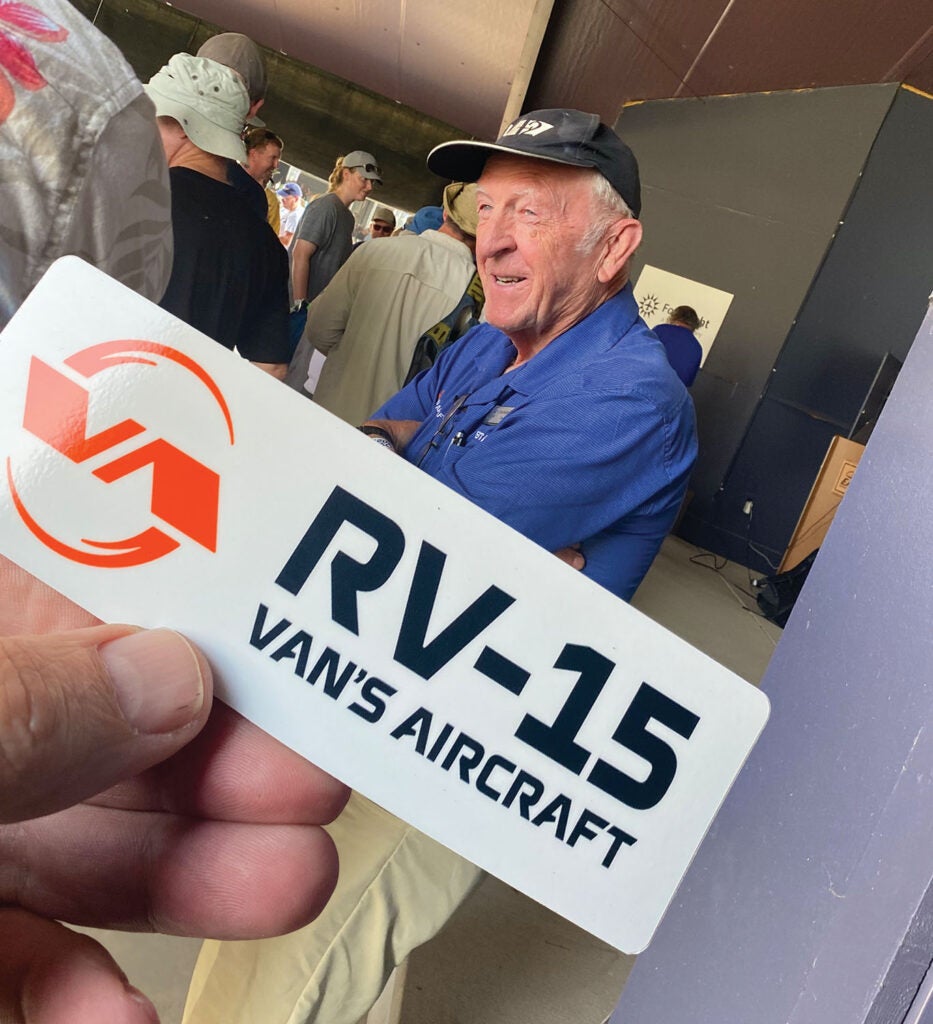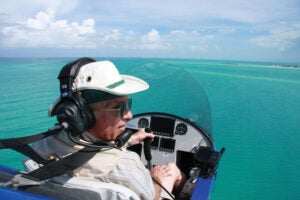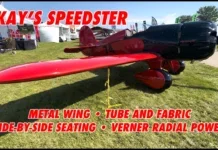No doubt you’ve seen some of our AirVenture coverage online—there sure was enough of it. Fourteen contributors, myself included, posted 85 stories over the week, ranging from you-are-here features to new-product updates. With one notable exception, there wasn’t a lot of new product announced at the show. For example, we didn’t see any new hardware from Garmin or Dynon. No new conventional engines appeared, and what we had on the airframe front was largely status quo.
Largely, but not wholly, as the announcement of Van’s RV-15 came early and rippled through the show like the chunky kid cannonballing into the pool at your Labor Day BBQ. There was some pushback among our readers that the Van’s announcement was light on details, but I see the company’s admission that, yes, a high-wing, backcountry airplane was going to be its next project as a critical milestone. There was so much talk in the RV community, including raw speculation, that it made sense for Van’s to announce something.
What remains, then, is to know more about it. (Well, yeah, and then to fly it, etc, etc…) What I and everyone else in the day-one forum have been able to glean is that it’s a high-wing model that, while still embracing Van’s mantra of “total performance,” will be aimed more at the backcountry, STOL-centric crowd than any of its previous models. (It’s fair to point out that you can land an RV-9 or RV-10 quite slowly, which helps reduce runway requirements.)
But one would expect the RV-15 to be “extra beefy” to stand up to the pounding the gravel-bar set is likely to offer it. We know it’ll have sticks and not yokes, and that it’ll first be built as a taildragger then converted into a trike. It’s not clear if it’ll be easily convertible once built. My casual read on that feature is that most original builders do it one way and generally stick with that configuration, but the ability to go from one to the other adds value for subsequent owners.
What We Don’t Know

We know it’s a high wing, sure, but nothing’s been said whether it’ll be strut-braced like countless Cessnas or with a cantilevered wing, perhaps making it something of an upside-down RV-9. Van’s says a few configuration items have been considered, but they’re being awfully cagey about which ones have been locked down. While a no-strut airplane might look fairly rakish, the configuration typically comes with a weight penalty and the need to locate a thick spar right where the pilot sits. We also don’t know things like engine choice, seating arrangement—two or four seats, perhaps a two-plus-two, or even tandem seating—or general size. I don’t think it’s a stretch to assume Van’s will work with materials (mostly metal) and powerplants (four- or six-cylinder Lycomings) that it has the most experience with.
At the AirVenture forum, newly promoted President and CTO Rian Johnson queried the crowd on the preference of conventional driven rivets or pull rivets (the attendees overwhelming voted for driven rivets), but he let on that his engineers have been tasked with exploring both options in the initial design phase.
You can bet that a lot of CAD work has been committed, and I know that an ergonomic mockup—the “pine pigeon”—has been constructed. As far as I understand, a full-size version has not yet been built, though I suspect they’ve already begun cutting metal on some key parts of the project. Don’t forget that Van’s recently invested in a new CNC machine and bought a massive press from Ford. Van’s says we’ll see more by next year, and I have hopes that the prototype will be flying in 2022. But the company is nothing if not meticulous about the handling qualities and performance of its designs, and it’s absolutely no secret that if the initial prototype doesn’t meet internal goals, they’ll keep working until it does.
AV-30 Updates, Plus
Our September issue went to press before AirVenture started, so my update story on the uAvionix AV-30 instrument ended up a little incomplete. At the show, I caught up with COO Ryan Braun (no, not the former Brewers center fielder), who gave me the lowdown on some new features. I have been flying with the AV-Link wireless adapter to give traffic on the AV-30, but Braun also confirmed that the company is working with electronic flight bag programmers to take the AV-30 attitude and pitot/static information out to connected devices.
What’s more, Braun said the company is working with BendixKing (TruTrak) to have the AV-30 provide a heading reference as well as altitude preselect and vertical-speed hold commands to the autopilot. He said that other autopilot integrations are in the works for both digital and analog designs. uAvionix is also working on an ARINC-429 connection to navigators to provide lateral guidance on the instrument. And while not an officially announced feature, the latest version of the firmware—introduced to improve DG performance—includes a menu item referencing a magnetometer. Currently, the AV-30 shows either an internally stabilized but unslaved directional gyro or displays GPS ground track. No word on the availability of the magnetometer, but I’ve flown with the updated DG software, and it’s a big improvement in display stability.

Dave Martin’s Legacy
Notes have been rolling in from readers and industry people all month, fondly remembering Dave Martin. Phil Lockwood wrote to say, “He and I became good friends during his time at KITPLANES®. This photo (right) is from one of our Bahamas AirCam fly-ins he attended in October of 2008. He flew out and back to Marsh Harbour from Sebring with me in our demo AirCam. I should say I rode with him, as he did all of the flying except for briefly relinquishing the controls from time to time while he did his photography. Dave was a straight shooter. Understated and reliable. A true aviation buff. He was frugal in a good way. The kind of frugality you admired as he always managed to do more for less. But most of all, I think he was a gentleman.”














Seen the new Sling High-Wing?
Yes we have. It wasn’t at AirVenture, but we’re planning to fly one soon. The company is making some changes to the prototypes, and once those are done, we’ll sample it.
Ladies, Gentlemen,
Mr. Dye’s report about the “Electric Xenos, August 2021” brought another motor glider to mind: Eric & Irena Raymond’s Sunseeker DUO. Since we have not heard of them in a while, would it be a good idea to look at that plane and let us know?
For Sailplane & Motorglider enthusiasts the Sunseeker DUO is the ultimate homebuilt: Electric powered and recharged by sunlight during flight, two persons side by side and still a glide ratio which most likely can compete with Standard Class Sailplanes – those that can be flown over long distances for hours…
Oh, and with an advanced e-motor and therefore no reduction drive!
Thanking You in advance!
Why, oh Why, did Textron “orphan” the Ttx ? The plane is Superior to the Cirrus SR22T and was much less expensive. The Mexican factory’s dangerous quality-control issues resulted in an FAA fine levied upon Textron. Yes, that was a potentially-devastating misstep and, yet, also an opportunity for Textron to salvage the entire Columbia 300/400/Ttx image by creating a separate Brand. That might have been done when the planes were still being manufactured in Lance-Land (as I referred to the non-Union Oregon homes of LanceAir).
Single-Engine Cessna airplanes are High-Winged beasties, not low-winged. Period. Full Stop (as the Brits say). We all saw the image and consequent branding issues from our vantage points outside Cessna (and Textron) management. Did Jack Pelton miss those issues ? Hindsight being more accurate than foresight (if not quite 20/20), Textron may be leaving money on the table by refusing to resurrect the Columbia 300/400/Ttx as a separate, somewhat-affordable brand (manufactured outside the influences of both the UAW and the Aerospace Machinists unions). Build them in the Maritimes (Frederickton, New Brunswick comes to mind). Equip them with a non-Boris ballistic chute, non-Garmin glass, a Three-Axis autopilot (from Moog/Genesys/S-Tec) and keep the fixed, trike gear. The questions become whether or not: 1) Textron realizes that the Bonanza (with that retractable gear) is living on borrowed time; and, 2) Textron sees Siemens hybrid-electric power as the low-operating-cost future. Lawn-care products may be more profitable than Single-Engine, Civilian (not military) aircraft…but where is the sex appeal?